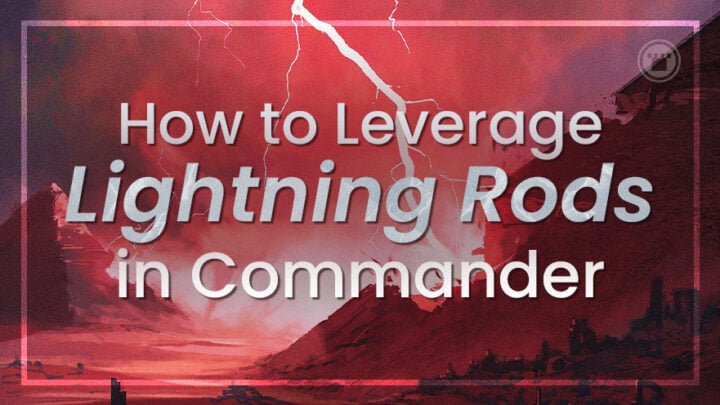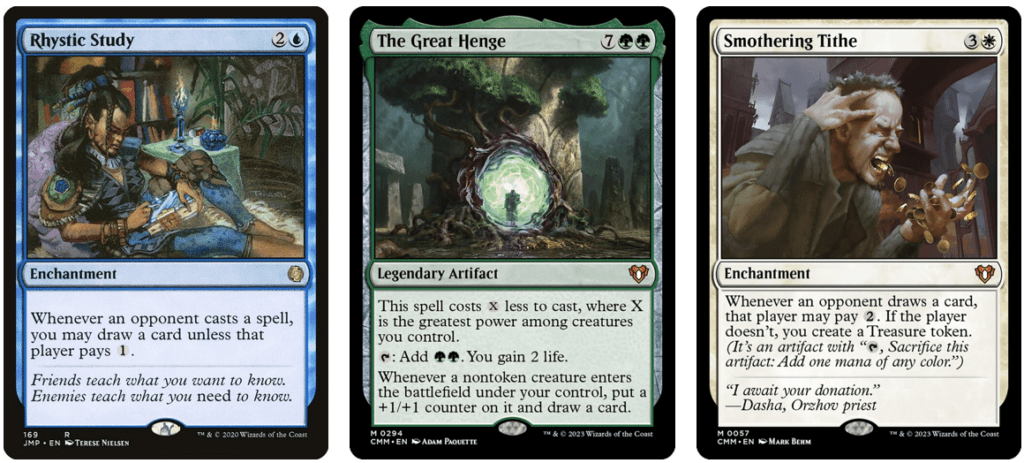The secret to running must-answer threats in Commander is to run other must-answer cards alongside them. Once you practice deploying a Lightning Rod, you’ll find you can stick your favorite haymakers and game-winning permanents much more often.
Some Commanders are kill on sight. Some nonland permanents are similarly… kill on sight. There are few things worse in Commander than tapping out to play something you really need to, on curve, only to have your entire turn negated because you decided to put something too heavy on the Donkey and triggered the “buckaroo!”.
Sometimes, that’s inevitable. Adding something to the board can trigger a boardwipe, especially if there’s enough on there to make the wipe a good prospect. Other times, you’ll inflate your threat level so high by dropping something like Smothering Tithe or Miirym that you’ll eat removal or a counter before you can say “But X threat is right there!”.
Whether it’s your Commander or a high-value synergy piece – or dare I say, a win condition – people will obviously remove things that seem to spike your deck’s performance. This goes double if your Commander is kill on sight AND a win con, or triple if it does those things and provides your value, too.
We all know how to use protection and counterspells to protect these game pieces, but what about using lightning rods? Do you know what the concept of a lightning rod is?
USING A LIGHTNING ROD IN COMMANDER
A lightning rod – in the real world – is a piece of technology that draws in lighting during a storm. It seeks to provide a path of least resistance to the incoming electrical energy, routing it away from more sensitive or delicate sites of impact. Lightning rods are commonly deployed around places like data centers and server farms to ensure that the expensive and critical infrastructure is safe from storms.
In Commander, a lightning rod is a term we give to a card that eats removal. All the removal. “Your Commander is a lightning rod, how do you deal with it?”, you might be asked. Well, the easiest way to deal with it is to use the same principle. Deploy more lightning rods.
ENTER ADELINE, RESPLENDENT CATHAR
Take Adeline as an example. She’s your Commander, and she is notorious for getting out of hand quickly. She summons legions of Humans, and if you don’t snipe her quickly, she’ll end up three or even two hitting you out of the game with Commander damage.
People will hold removal for her. So what can you do? Well, you can run cards people will want to remove instead, as you curve out.
Cards like Guide of Souls and Serra Ascendant are cards you want to be running anyway, but the reason so many Adeline players jam them at such a high rate is because while being good, they also help to soak up removal spells that would otherwise hit Adeline. If left unchallenged, they will similarly run away with the game. Your Adeline is more likely to last around the table when there’s the prospect of a continuous evasive 12-point life swing, or your board consistently growing into flying threats.
The alternative to doing this is, of course, to use protection. Blacksmith’s Skill or Teferi’s Protection in hand can do a lot in mono white, as can deploying Mother of Runes or Giver of Runes ahead of dropping your Adeline into play.
You can’t always hold mana up for protection, though, and deploying a curve out piece that benefits you doesn’t always attract the removal you want it to – especially if multiple opponents are deploying value engines. Many players play more reactively than proactively in Commander (for better or worse), and so they tend to only remove something if it’s a problem or annoyance to them personally.
ENTER HATEBEARS & STAX
So, I do want to preface this with saying that hatebears aren’t even that good in cEDH these days. And, if you haven’t read my article that introduces the concept of “Goopy Goblin Gamer Brain” to Commander, then you absolutely should do. The tl;dr is basically that the majority of casual Commander players are too impatient to play around even with stax-lite effects, and don’t consider the role they play at a table in the context of each player other than themselves. The net result is that they tend to remove them with extreme prejudice.
What can you gain from this knowledge? Well, knowledge is power. Leverage it. Hatebears can be the lightning rods in your deck 🙂
The golden rule, if you like, is people will always prefer to remove something that slows them down than something that helps you win unless you’re actively winning. The reason why is mostly goopy goblin gamer brain, but it’s also because in some cases, opening up their own plays and racing you is objectively correct.
So, back to Adeline. What lightning rods can we run?
Authority of the Consuls and Thalia, Heretic Cathar are notorious for being removed at tables I play at. People really don’t enjoy their stuff coming in tapped. The bonus in Adeline is that they help our tapped and attacking Humans attack easier, and in the case of the enchantment, play into potential lifegain subthemes.
Another option is to run something that can enable Adeline’s attack trigger when she’s unable to attack profitably. Preferably, something that will eventually eat the removal that Adeline would otherwise eat. Hushbringer is perfect for this, but if you don’t want to turn off your own triggers, you can probably find something equally annoying and evasive.
APPLYING LIGHTNING ROD STRATEGY TO OTHER PERMANENTS
It’s not just Commanders – or creatures – that you’ll want to deploy lightning rods for. You also need to
Let’s extrapolate that to another game piece: Enchantments
If you’re running Doubling Season and other busted doublers, then you’re incentivized to run other must-answer powerful enchantments too, and often, those enchantments benefit from being run alongside each other. There’s only so much removal to go around.
So, you can run Rhystic Study, The Great Henge, Smothering Tithe and other powerful pushed artifacts and enchantments alongside your powerful ones, because the threat level on them is all quite demanding. You can run your busted powerful enchantments more confidently, because there’s only so much removal.
This is, in many ways, one of the reasons higher power decks tend to scale exponentially compared to decks lower on the power spectrum. By being able to play many game-warping permanents alongside each other, their resilience and overall power level is higher by orders of magnitude, rather than just linearly. It’s why running only one or two of this type of card is way less impactful – Smothering Tithe can be removed, and people won’t be as scared about the next thing.
IT’S ABOUT NORMALIZING YOUR POWER LEVEL
Funnily enough, in deciding whether you need or want to run lightning rods, you’re also engaging in a level of architectural thinking in deckbuilding that speaks to power level. Are you content with higher variance gameplay, and is your playgroup? Or do you want your deck to have a flatter and more consistent experience, not only as a pilot, but for other players, to help them with threat assessment?
To simplify what I mean, consider Academy Manufactor in a Food deck. It’s kill on sight, you know that. But the reason it hardly ever makes its way around the table is because it spikes the power level of those decks in such a way that it creates noticeable tension at the table. If this thing is in a deck centered around making lots of treasure, or a deck like Marneus Calgar, that will be making all sorts of tokens, playing Anointed Procession, and drawing a million cards in Esper? Well, the overall threat of the card is flatter and more “normalized”.
END STEP
In essence, a secret to keeping your lightning rod permanents in play is to make sure that the threat level across all of your permanents is as flat as possible. Running one game-changing creature like Avacyn in an Angels deck isn’t going to go well. But running other lightning rods like Serra’s Emissary, Gisela & Bruna, and hate bears like Linvala, Keeper of Silence rapidly ups the chance that you’ll get to resolve at least one of them, so that they can have an impact on the game.

Kristen is Card Kingdom’s Head Writer and a member of the Commander Format Panel. Formerly a competitive Pokémon TCG grinder, she has been playing Magic since Shadows Over Innistrad, which in her opinion, was a great set to start with. When she’s not taking names with Equipment and Aggro strategies in Commander, she loves to play any form of Limited.






